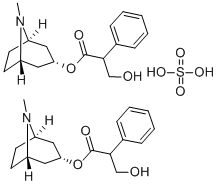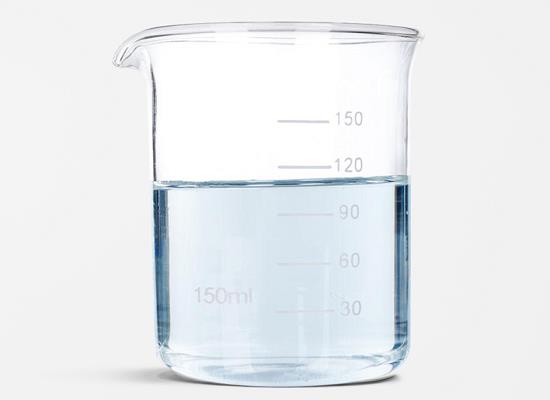Atropine Sulfate: Pharmacodynamics, Pharmacokinetics and Toxicity
General Description
Atropine sulfate is an antimuscarinic agent known for its significant effects on cardiac and respiratory functions, primarily by antagonizing acetylcholine. It exhibits dose-dependent pharmacodynamics, effectively reducing heart rate and increasing respiratory rate via bronchiolar dilation. Pharmacokinetically, atropine sulfate shows variable absorption, a wide distribution volume, and considerable protein binding. It undergoes hepatic metabolism, leading to various metabolites, with a significant elimination rate of 13 to 50 percent in urine. Toxicity from high doses can result in severe symptoms, including circulatory collapse and respiratory failure. Supportive treatment is essential for managing atropine sulfate overdose, with an acute oral toxicity (LD50) of 75 milligrams per kilogram in mice.

Figure 1. Atropine sulfate
Pharmacodynamics
Cardiac and Respiratory Functions
Atropine sulfate is a well-known antimuscarinic agent that plays a crucial role in modulating the effects of acetylcholine in the body. At lower doses, atropine sulfate functions to decrease heart rate due to its ability to antagonize vagal control, thereby potentially leading to tachycardia. Notably, atropine sulfate exhibits a more pronounced and sustained impact on cardiac and smooth muscle tissues compared to other similar agents, such as scopolamine. Its influence on respiratory function is significant, as atropine sulfate enhances both the rate and depth of respiration. This effect is primarily attributed to bronchiolar dilation rather than any major change in vagal tonicity. The pharmacodynamics of atropine sulfate also extend to its ability to eliminate reflex vagal responses, thereby preventing bradycardia and asystole that may arise from the administration of choline esters or other parasympathomimetic substances. 1
Mechanistic Action
The mechanism of action of atropine sulfate is centered around its competitive inhibition of muscarinic acetylcholine receptors, which disrupts the normal action of acetylcholine and choline esters. Atropine sulfate demonstrates an affinity for various muscarinic receptor subtypes, including M1, M2, M3, M4, and M5. By acting as a reversible non-specific antagonist, atropine sulfate effectively blocks the effects of acetylcholine on multiple tissues, including smooth muscle, cardiac tissue, and exocrine glands. In clinical settings, this mechanism is utilized to counteract unwanted physiological responses induced by vagal stimulation, such as reducing the likelihood of bradycardia. However, the therapeutic effects of atropine sulfate can be mitigated if acetylcholine levels increase significantly, highlighting the nuanced balance of its pharmacodynamics. While beneficial in many scenarios, the use of atropine sulfate can also lead to adverse events such as glaucoma, urinary retention, and thickening of bronchial secretions, particularly in susceptible patient populations. 1
Pharmacokinetics
Absorption Characteristics
Atropine sulfate exhibits distinct absorption characteristics depending on the route of administration. When administered intravenously, atropine sulfate demonstrates a non-linear pharmacokinetic profile for doses ranging from 0.5 to 4 milligrams. In adults receiving intramuscular administration of 1.67 milligrams of atropine sulfate, the peak plasma concentration (Cmax) reached 9.6 nanograms per milliliter, with the time to peak concentration (Tmax) varying from 3 to 60 minutes. Furthermore, studies with healthy individuals show that when 30 microliters of atropine sulfate is delivered via ophthalmic solution, the Cmax achieved is approximately 288 picograms per milliliter, and Tmax is around 28 minutes. Additionally, atropine sulfate is efficiently absorbed through the gastrointestinal tract, leading to rapid systemic circulation. The bioavailability of intramuscularly administered atropine sulfate is noted to be around 50 percent, and interestingly, females exhibit higher area under the curve (AUC) and Cmax values than males, by approximately 15 percent. 2
Distribution and Protein Binding
Once absorbed, atropine sulfate is widely distributed throughout the body. Following intravenous administration, the total apparent volume of distribution for atropine sulfate ranges between 1.0 and 1.7 liters per kilogram. This extensive distribution indicates that atropine sulfate is capable of penetrating various tissues, which is crucial for its therapeutic effects. Regarding protein binding, atropine sulfate exhibits variable binding rates, typically ranging from 14 percent to 44 percent, with saturation occurring at concentrations between 2 and 20 micrograms per milliliter. This protein binding may influence the pharmacological activity of atropine sulfate and its overall effectiveness, as bound atropine sulfate may be less available for action at target sites. 2
Metabolism and Elimination
Atropine sulfate undergoes significant metabolism primarily through enzymatic hydrolysis in the liver, leading to the formation of several metabolites, including noratropine, atropin-n-oxide, tropine, and tropic acid. Importantly, the metabolism of atropine sulfate can be inhibited by organophosphate pesticides, affecting its overall pharmacokinetics. In terms of elimination, studies indicate that approximately 13 to 50 percent of atropine sulfate is excreted unchanged in the urine. Notably, in trials with healthy volunteers following intravenous administration, about 29 percent of tropine, a key metabolite, was found in the urine along with 15 percent of an unidentified metabolite. The half-life of atropine sulfate varies considerably, typically ranging from 2 to 4 hours for intravenous and intramuscular doses. However, in geriatric patients aged 65 to 75 years, the half-life can extend to approximately 10 hours, highlighting age-related pharmacokinetic variations. Moreover, females tend to have a slightly shorter half-life of around 20 minutes compared to males. After topical ocular administration, the half-life of atropine sulfate is reported to be approximately 2.5 hours, underscoring the diverse pharmacokinetic profiles depending on the method of administration. 2
Toxicity
Atropine sulfate can exhibit significant toxicity, particularly at high doses. Symptoms of atropine sulfate toxicity may include palpitations, dilated pupils, difficulty swallowing, and hot dry skin. Additional effects can involve severe restlessness, hallucinations, delirium, and even coma in extreme cases. Consequently, toxic doses of atropine sulfate can lead to circulatory collapse, resulting in decreased blood pressure and respiratory failure, which may ultimately culminate in death. Treatment for atropine sulfate overdose focuses on supportive care, including ensuring adequate ventilation and hydration, managing urinary retention, and controlling severe agitation with caution. The acute oral toxicity level of atropine sulfate (LD50) in mice is noted to be 75 milligrams per kilogram. 1
References:
[1] J KANTO U K. Pharmacokinetic implications for the clinical use of atropine, scopolamine and glycopyrrolate.[J]. Acta Anaesthesiologica Scandinavica, 1988, 32 2. DOI:10.1111/j.1399-6576.1988.tb02691.x.See also
Lastest Price from Atropine sulfate manufacturers

US $5.00-0.50/KG2025-06-20
- CAS:
- 55-48-1
- Min. Order:
- 0.10000000149011612KG
- Purity:
- 99% hplc
- Supply Ability:
- 5000kg

US $1.00/KG2025-04-21
- CAS:
- 55-48-1
- Min. Order:
- 1KG
- Purity:
- 99%
- Supply Ability:
- 10 mt


